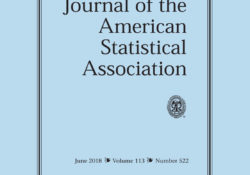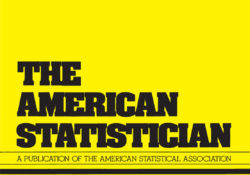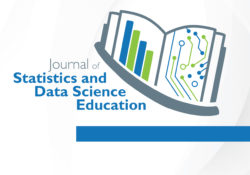eric.ed.gov har udgivet: The purpose of these modules is to provide an introduction to the world of probability and statistics to accelerated mathematics students at the high school level. The modules also introduce students to real world math concepts and problems that property and casualty actuaries come across in their work. They are designed to be used by teachers and students of AP courses (primarily AB and BC Calculus) after the AP exam, but of course they can be used at any time. Statistical thinking is critical in today’s society. Data are everywhere and students will see and recognize misinterpretations all the time. “Probability & Statistics: Modular Learning Exercises” cover: (1) Basic Statistics Concepts; (2) The Normal Model; (3) Discrete Probability Distributions; and (4) Correlation and Regression. Link til kilde
Like this:
Like Loading...
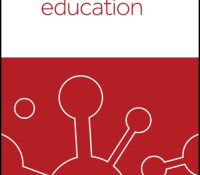
tandfonline.com har udgivet en rapport under søgningen “Teacher Education Mathematics”: Abstract Abstract Motivated by experience with students’ psychological barriers to learning statistics, we modified and extended the Statistical Anxiety Rating Scale (STARS) to develop a contemporary and valid (face, content, criterion and construct) Danish measure of attitudes and relationship towards statistics for use with higher education students taking statistics within another discipline. Two subscales were excluded because of lack of conceptual unidimensionality or derogatory content, and single items were modified for face and content validity enhancement in the remaining subscales. Following a pilot study and main study, the resulting 26-item Danish instrument (HFS-R for “holdninger og forhold til statistik – Revideret”, in English “Attitudes and Relationship to Statistics – Revised”) consists of four subscales: Test and Class Anxiety (TCA), Interpretation… Continue Reading →
Like this:
Like Loading...
tandfonline.com har udgivet en rapport under søgningen “Teacher Education Mathematics”: ABSTRACT ABSTRACT Each year, the Journal of the American Statistical Association publishes the presidential address from the Joint Statistical Meetings. Here, we present the 2017 address verbatim save for the addition of references and a few minor editorial corrections. Link til kilde
Like this:
Like Loading...
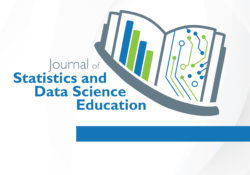
tandfonline.com har udgivet en rapport under søgningen “Teacher Education Mathematics”: ABSTRACT ABSTRACT The CASE project (Case-based Approaches to Statistics Education; see www.mas.ncl.ac.uk/∼nlf8/innovation) was established to investigate how the use of real-life, discipline-specific case study material in Statistics service courses could improve student engagement, motivation, and confidence. Ultimately, the project aims to promote deep learning of course material, with students from other disciplines being equipped with the skills to undertake independent quantitative analyses (for example, in their final year dissertations). In this article, I describe the case-based materials and associated activities, developed as part of this project, for first year Business undergraduates taking a compulsory course in quantitative methods. I also attempt to evaluate the success of the CASE project through a trial in which a randomly selected subgroup of students… Continue Reading →
Like this:
Like Loading...
eric.ed.gov har udgivet: Created by teachers for teachers, the Math Academy tools and activities included in this booklet were designed to create hands-on activities and a fun learning environment for the teaching of mathematics to the students. This booklet contains the “Math Academy–Play Ball! Explorations in Data Analysis & Statistics,” which teachers can use to enhance their math instruction while staying true to the academic rigor required by the state standards framework. Included in this booklet are activities the author used for the sports Math Academy. This Math Academy is designed to help students understand the connection between sports, data collection, and statistical analysis. As the students play each “game,” they will collect, organize, display, and analyze the data from the game results. Teachers may choose to implement a grade-level… Continue Reading →
Like this:
Like Loading...
tandfonline.com har udgivet en rapport under søgningen “Teacher Education Mathematics”: ABSTRACT ABSTRACT Over two semesters short essay prompts were developed for use with the Graphical Interface for Knowledge Structure (GIKS), an automated essay scoring system. Participants were students in an undergraduate-level online introductory statistics course. The GIKS compares students’ writing samples with an expert’s to produce keyword occurrence and links in common scores which can be used to construct a visual representation of an individual’s knowledge structure. Each semester, students responded to the same two essay prompts during the first and last week of the course. All responses were scored by the GIKS and two instructors. Evidence for the validity of scores obtained using the GIKS was provided through the use of correlations with instructors’ scores and final exam scores.… Continue Reading →
Like this:
Like Loading...
tandfonline.com har udgivet en rapport under søgningen “Teacher Education Mathematics”: Abstract Abstract The “New Statistics” emphasizes effect sizes, confidence intervals, meta-analysis, and the use of Open Science practices. We present three specific ways in which a New Statistics approach can help improve scientific practice: by reducing overconfidence in small samples, by reducing confirmation bias, and by fostering more cautious judgments of consistency. We illustrate these points through consideration of the literature on oxytocin and human trust, a research area that typifies some of the endemic problems that arise with poor statistical practice. Link til kilde
Like this:
Like Loading...
tandfonline.com har udgivet en rapport under søgningen “Teacher Education Mathematics”: Abstract Formulae display:?Mathematical formulae have been encoded as MathML and are displayed in this HTML version using MathJax in order to improve their display. Uncheck the box to turn MathJax off. This feature requires Javascript. Click on a formula to zoom. Abstract Teaching some concepts in statistics greatly benefits from individual practice with immediate feedback. In order to provide such practice to a large number of students we have written a simulator based on an historical event: the loss in May 22, 1968, and subsequent search for the nuclear submarine USS Scorpion. Students work on a simplified version of the search and can see probabilities change in response to new evidence. The simulator is designed to assist in the teaching… Continue Reading →
Like this:
Like Loading...
tandfonline.com har udgivet en rapport under søgningen “Teacher Education Mathematics”: ABSTRACT ABSTRACT Mnemonics (memory aids) are often viewed as useful in helping students recall information, and thereby possibly reducing stress and freeing up more cognitive resources for higher-order thinking. However, there has been little research on statistics mnemonics, especially for large classes. This article reports on the results of a study conducted during two consecutive fall semesters at a large U.S. university. In 2014, a large sample (n = 1487) of college students were asked about the usefulness of a set of 19 published statistics mnemonics presented in class, and in 2015, the students (n = 1468) were presented 12 mnemonics related to inference and then asked whether or not they used mnemonics on that exam. This article discusses how… Continue Reading →
Like this:
Like Loading...
tandfonline.com har udgivet en rapport under søgningen “Teacher Education Mathematics”: ABSTRACT Formulae display:?Mathematical formulae have been encoded as MathML and are displayed in this HTML version using MathJax in order to improve their display. Uncheck the box to turn MathJax off. This feature requires Javascript. Click on a formula to zoom. ABSTRACT A repeated crossover experiment comparing learning among students handing in pen-and-paper homework (PPH) with students handing in web-based homework (WBH) has been conducted. The system used in the experiments, the tutor-web, has been used to deliver homework problems to thousands of students in mathematics and statistics over several years. Since 2011, experimental changes have been made regarding how the system allocates items to students, how grading is done, and the type of feedback provided. The experiment described here… Continue Reading →
Like this:
Like Loading...

